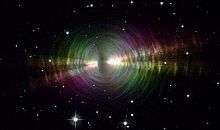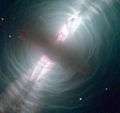Egg Nebula
Coordinates: ![]()
| Reflection nebula | |
|---|---|
| Protoplanetary nebula | |
 RAFGL 2688, the Egg Nebula | |
| Observation data: J2000 epoch | |
| Right ascension | 21h 02m 18.75s[1] |
| Declination | +36° 41′ 37.8″[1] |
| Distance | approx[2] 3000 ly (920 pc) |
| Apparent magnitude (V) | 14.0[1] |
| Apparent dimensions (V) | 30″ × 15″ |
| Constellation | Cygnus |
| Physical characteristics | |
| Radius | 0.2[a] ly |
| Absolute magnitude (V) | 4.2[b] |
| Designations | Cygnus Egg[1] |
The Egg Nebula (also known as RAFGL 2688 and CRL 2688) is a bipolar protoplanetary nebula approximately 3,000 light-years away from Earth. Its peculiar properties were first described in 1975 using data from the 11 µm survey obtained with sounding rocket by Air Force Geophysical Laboratory (AFGL) in 1971 to 1974. (Previously, the object was catalogued by Fritz Zwicky as a pair of galaxies.)
The Egg Nebula's defining feature is the series of bright arcs and circles surrounding the central star. A dense layer of gas and dusts enshrouds the central star, blocking its direct light from our view. However, the light from the central star penetrates the thinner regions of this dusty enclosure, illuminating the outer layers of gas to create the arcs seen in this resplendent image (Hubble Site).
The dusty enclosure around the central star is very likely a disc. The bipolar outflows in the image indicate that the system has angular momentum, which is very likely generated by an accretion disc. In addition, a disc geometry would account for the varying thickness of the enclosure that allows light to escape along the disc's axis and illuminate the outer layers of gas, but still blocks it from our direct view along the disc edge. Although dusty discs have been confirmed around several post-AGB objects (S. De Ruyter et al., 2006), a disc around the Egg Nebula is yet to be confirmed.
The Egg Nebula was photographed by the Wide Field and Planetary Camera 2 of the NASA/ESA Hubble Space Telescope.
The Egg Nebula emits polarized light[3] which can also be detected visually by a medium-sized telescope.[4]
Gallery
 Image produced from exposures in visible and infrared light from Hubble’s Wide Field Camera 3.[2]
Image produced from exposures in visible and infrared light from Hubble’s Wide Field Camera 3.[2]
Notes
References
- 1 2 3 4 5 6 7 "V* V1610 Cyg". SIMBAD. Centre de données astronomiques de Strasbourg. Retrieved 2007-01-05.
- 1 2 "Hubble Images Searchlight Beams from a Preplanetary Nebula". ESA/Hubble Picture of the Week. Retrieved 24 April 2012.
- ↑ Raghvendra Sahai; et al. (January 1998). "The Structure of the Prototype Bipolar Protoplanetary Nebula CRL 2688 (Egg Nebula): Broadband, Polarimetric, and H2 Line Imaging with NICMOS on the Hubble Space Telescope". The Astrophysical Journal Letters. 492 (2): L163–L167. Bibcode:1998ApJ...492L.163S. doi:10.1086/311108. Retrieved 6 July 2013.
- ↑ "Proto-planetary Nebulae". Retrieved 6 July 2013.
- Hubble Finds Searchlight Beams and Multiple Arcs around a Dying Star. STScI Press release: Space Telescope Science Institute. January 16, 1996.
- De Ruyter et al. Keplerian discs around post-AGB objects: a common phenomenon? Astronomy & Astrophysics 448, 641–653 (2006).
External links
| Wikimedia Commons has media related to Egg Nebula. |
- Merrifield, Michael. "Egg Nebula". Deep Space Videos. Brady Haran.